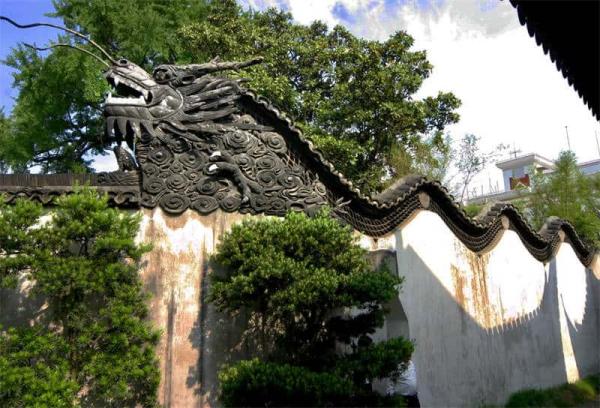Dragon in Ancient Chinese Architecture
Chinese architecture is one of the three major architectural systems in the world, together with European architecture and Islamic architecture. And, “dragon” can be seen everywhere of traditional Chinese architecture.

The concept of "dragon vein" in ancient Chinese geography has a considerable influence on the site selection and layout of Chinese cities and buildings, and there are countless cases of using the image of dragon as architectural decoration in ancient Chinese buildings: the curled-up dragon on the ornamental columns of Tian 'anmen Square, the Nine Dragon wall of the North Sea, the flying dragon of the Confucius Temple in Beijing, the cloud dragon stone column of the Confucius Temple in Qufu, the curled-up dragon stone carving on the bridge board of Zhaozhou in the Sui Dynasty, and the curled-up dragon column base of the Sima Golden Dragon Tomb of the Northern Wei Dynasty...
Jinci Temple in Taiyuan
Hall of Goddess of Jinci Temple is a wooden building that consists of the base, beam and column structure system and roof. This hall is closely related to the dragon culture. The base on the railing below the stone faucet, used to drain rainwater. The 8 wooden columns are each carved with a wooden dragon, of different postures, like the patron saint of the hall, also marking the noble and extraordinary status of the Goddess hall. At the ridge two dragons are kissing. In addition, the peak beast, the horn beast and the nestal beast on the horn beam all reflect the dragon form, making the ornaments of the dragon everywhere on the whole roof.

Dragon in Forbidden City
By the Ming and Qing Dynasties, dragon ornaments became the main decoration of royal palaces. The Forbidden City in Beijing takes dragon culture to the extreme. Outside the foundation of the temple, there is a water-spitting chi head. The three main halls are made of white marble and have a total of 1,142 dragon heads. On rainy days, one can see the magnificent scene of a thousand dragons spitting water. Three layers of pedestal are around the white marble balustrade, a total of 1458, looking at the capital carved cloud dragon, can be called the sea of dragons.Entering the Hall of Supreme Harmony, one can see a golden dragon throne, seven golden dragon screens behind the seat, a gold dragon caisson on the top, and a ceiling covered with gold and seal color paintings. In the center of the hall, there are six pink gold lacquer dragon columns, which add luster to the ten thousand golden dragons in the hall, resplendent and golden, forming a golden dragon world.

The Nine Dragon wall of the Forbidden City in Beijing is set in yellow glazed tiles. Rafter, purlin and bracket are set under the eaves. A yellow dragon in the the middle of the Nine Dragon Wall is the king of all dragons,. The white dragon in the wall is the rising dragon, and the blue dragon is the falling dragon. The double dragon on the outside of the Nine Dragon Wall consists of one yellow and one purple. The Nine Dragon wall of the Forbidden City has totally 270 plastic pieces, a multiple of 9 and 5 (a symbol of imperial authority).
In the Forbidden City, there is a dragon throne in the Taihe Hall (also known as Emperor's Audience Hall or throne room). The dragon throne is a wooden chair of gold carved dragon, symbolizing the supreme feudal imperial power. It had an "arm-chair" back, and four columns decorated with gold dragons. The whole chair is decorated with gold, looking magnificent and imposing. According to the research of cultural relics experts in the Palace Museum, the existing dragon throne was made in the Ming Dynasty and may be a relic from the reconstruction of the Emperor Jiajing's Imperial Pole Hall.
Panloong sunk panel
Panloong sunk panel is decorated with dragon design on the top of the sunk panel. It is the highest level of sunk panel in ancient China, and only used in the palace related to the emperor and the highest level of ritual altar temple. In the Palace Hall of Forbidden City, there is a dragon sunk panel on the ceiling above the dragon throne.

The Nine Dragon wall in Datong
The Nine Dragon Wall in Datong was built in the 25th year of Hongwu in the Ming Dynasty (1392). It is the front wall of the mansion of royal highness Zhugui, the thirteenth son of Emperor Zhu Yuanzhang of the Ming Dynasty.It has a history of more than 600 years. The wall is 8 meters high, 2.02 meters thick and 45.5 meters long. There are nine flying dragons evenly and harmoniously distributed on the wall. The two sides are moon and sun designs. The wall is made of 426 pieces of special colorful glass components.

Stone carving dragon Confucius Temple in Qufu
When think of stone carving dragon, we think the ten grinding stone dragon pillars before the main hall of Confucius Temple in Qufu. There are two cloud dragons on each column, dancing back to hover.
Dragon Walls in Yu Garden
Yu Garden is a famous classical garden in the South of the Yangtze River, ranking first among the five classical gardens in Shanghai.

The dragon walls distinguish Yuyuan Garden from other classical gardens. There are five dragons in the dragon wall of Yu Garden. They are different in shape and have their own characteristics. In the west of Dianchun Hall, there is a dragon wearing clouds. After the big rockery there is a lying dragon. Beside Hexu Hall two dragons are frolicking with a pearl; There is a sleeping dragon in front of the inner garden. The garden of more than 40 landscapes are skillfully separated by lifelike dragon walls, winding corridors and flowers of different shapes.
Keep reading: